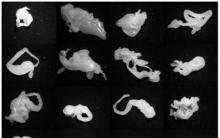Standard set: walks, cafes, beaches, shopping, museums. A musician (or a big music lover) will always try to find some good concerts on the ground, or visit a music museum. About one of the most famous such places, the Rock and Roll Hall of Fame,. And today we’ll tell you about a few more important for the history of music and interesting museums.
1. THE BEATLES STORY - LIVERPOOL, ENGLAND
The museum was founded in 1990 and is located in the basement of Albert Dock, on the territory of the historic buildings of the Port of Liverpool. At the entrance, visitors can receive an audio guide, including one in Russian. Moving from room to room, visitors observe the history of the birth and rise of the Beatles. Each room is dedicated to one of the periods in the history of the Beatles and its members: the birth of John Lennon's first group, the Quarrymen, the Beatles' trip to Hamburg, meeting Brian Epstein, performances at the Cavern club, and so on, until the group's breakup in 1970.
The museum contains unique exhibits: concert costumes and instruments of the band members, photographs, song lyrics, records, eyewitness memories and archival videos. A separate stand is allocated for gifts sent by Russian fans of the group. At the exit from the museum there is a souvenir shop with symbols legendary group. http://www.beatlestory.com
2. MUSEUM OF MUSIC AND SCIENCE FICTION - SEATTLE, USA

The main inspirer of the project is billionaire Paul Allen, a former Microsoft colleague of Bill Gates and a big fan of Jimi Hendrix. He had been hatching a similar project for many years. The idea to create such an unusual structure came to the architect Frank Gary after he cut up an electric guitar. He conceived the structure without precise forms and the correct arrangement of walls, windows and ceiling as a symbol of the plasticity and energy of music. After the building opened its doors in 2000, a Museum was added in 2004 science fiction and the hall of fame, and now the entire complex bears a single name - Experience Music Project and Science Fiction Museum and Hall of Fame.
The Science Fiction Museum's exhibition features a variety of science fiction books, magazines, newspapers and various items that were used in filming. Among the “fantastic” items you can see the seat of Captain Kirk from the legendary TV series “ Star Trek", the helmet of the evil Darth Vader from " Star Wars", as well as a huge alien, 6 meters high, from the movie "Aliens". http://www.empmuseum.org
3. BRITISH MUSIC EXPERIENCE - LONDON, ENGLAND

If you know the features of Noel Gallagher's favorite guitar and remember who Cliff Richards is, then you will get incredible pleasure from visiting the interactive exhibition located in London's largest arena, the O2. The museum was opened by the Scottish by The View in 2009.
Over 3000 photos and paintings, 600 video clips and the same number of items that belonged to pop and rock stars. There is also a collection of audio equipment from the 40s of the last century, an interactive studio, visitors have the opportunity to learn the “dance of the decade” (all alone!), try yourself as a DJ and learn everything about your favorite performer or group.
4. MUSIC CITY - PARIS, FRANCE

Musicograd is a group of institutions dedicated to music located in the La Villette quarter, in the 19th district of Paris. The structure was designed by the architect Christian de Portzamparc and opened in 1995. It houses a lecture hall, a concert hall with 800–1000 seats, a music museum with a significant collection of instruments dating mainly from the 15th–20th centuries, exhibition halls, rooms for practical training and archives. Music City, one of François Mitterrand's Great Projects, along with La Villette Park, reopened the former La Villette slaughterhouse area to the public.
5. BRAZILIAN WORLD MUSIC MUSEUM - SAO PAULO, BRAZIL

Over a million different releases are housed in this museum - it houses the largest collection of recordings in the entire South America. This is an archive and research center - they collect popular music of all countries and times. The artists represented here are not limited to those signed to labels - recordings by independent musicians can be found in the museum.
Also, one of the museum’s ambitions is to collect releases from each language group existing in the world. http://www.brazilworldmusicmuseum.com/
6. KALAKUTA MUSEUM - LAGOS, NIGERIA

In 2012, the Lagos City Government converted the home of Afrobeat legend Fela Kuti into a museum to “support cultural heritage and celebrate the 74th birthday of the multi-instrumentalist and active participant in the human rights movement. The museum houses a huge collection of Kuti's clothing, instruments, records and much more.
7. RAMONES MUSEUM - BERLIN, GERMANY

The Ramones Museum in Berlin opened a year after Johnny Ramone's death, on September 16, 2005. It was located on Solmsstrasse, and its exhibition consisted of more than 300 items somehow related to the group, among which were unique and one-of-a-kind items.
On his website you can read the following: “You may ask: why the hell did the first and only Ramones museum appear not in New York, Los Angeles, London, Tokyo, Rome, Buenos Aires, but in Berlin, Germany?” The history of the museum is connected with the name of Flo Hiler, who acquired the first things with Ramones symbols at a Berlin concert in 1990 and could no longer stop, having managed to personally communicate with the musicians several times.
In November 2007, the founder of the museum was forced to close it due to exorbitantly increased rent, but less than a year later, on October 8, 2008, the institution opened in a new location - and to this day it is located at Krausnickstraße 23. https://www ramonesmuseum.com/
8. BOB MARLEY HOUSE MUSEUM - KINGSTON, JAMAICA

Thousands of music lovers and tourists visit this Kingston landmark every year to learn more about the life lived by the legendary reggae artist.
The house behind the brick wall is painted with portraits of Marley. There is a sculpture in the courtyard - Bob Marley with his guitar. Newspaper clippings (with reports about the tour), numerous photographs, platinum and gold discs adorn the walls of the two-story house.
Everything here remains almost unchanged: a bedroom with a spacious bed covered with a bedspread in red, yellow and green tones, and on it lies a Bob Marley guitar in the shape of a star, a small kitchen. There are bullet holes on the walls, left over from the time when there was an assassination attempt on the singer in 1976. http://www.bobmarleymuseum.com/
9. JOHNNY CASH MUSEUM - NASHVILLE, USA

In the American capital of country music, Nashville, the Johnny Cash Museum opened in 2013 in honor of the 80th anniversary of the legendary musician, who died in 2003. The initiator of the opening of the museum was Bill Miller, a collector and expert on Cash’s work.
The exhibits include, among other things, memorabilia from the first Johnny Cash Memorial Museum in Tennessee, which existed until 1999. This collection was given to Miller by the country star's family. New Museum is located on one of the central streets of Nashville - Lower Broadway.
“Bill Miller provided invaluable support to my father during his lifetime,” noted Johnny Cash’s daughter, famous country singer Rosanne Cash, “and his collection must be the most complete in the world. The museum’s exhibits are selected in a highly professional and academic manner.”
The musician’s heirs plan to organize another museum - in the Cash family home in Diss, Arkansas. It is supposed to restore the interiors in which Cash grew up in the 30s and 40s.
Named after Glinka is one of the largest treasuries, which presents monuments musical art. It has no analogues in the world.
General information
The museum houses not only literary and music manuscripts, but also many studies, as well as rare books. The collection contains autographs and letters, various documents that are related to the work of famous cultural figures, both Russian and foreign.
Musical instruments of many peoples of the world are of particular interest. In 2010, the State Collection transferred to the Museum the largest collection of works by masters from different eras. Among them are masterpieces made by the hands of A. Stradivari, representatives of the Amati and Guarneri families. The Glinka Music Museum is proud of the oldest organs installed within its walls, including the work of F. Ladegast.
Main work
There are permanent exhibitions here. Dialogue concerts, excursions and recording evenings are organized upon prior request. Those interested can attend interactive classes, as well as educational children's parties.

Story
Its beginnings Museum musical culture them. Glinka takes from the Moscow Conservatory. It was here, from the first moment of its existence, that enthusiasts began to collect own initiative rare musical materials- documents and autographs, as well as manuscripts and instruments, which became the basis of today's collection.
On March 11, 1912, within the walls of a small hall next to the conservatory library, the Museum named after. N.G. Rubinstein. It was dedicated to the memory of this outstanding musical figure, who was especially loved by the capital's public. It was Rubinstein who founded the conservatory and the Moscow branch of the Russian Music Society. IRMO documents, rare instruments and books, his personal belongings, as well as letters and autographs were concentrated here.
Changes

Throughout its short history, the Glinka Museum has experienced both times of growth and difficult periods when it, being in complete oblivion, was on the verge of closure. For almost three decades, he played the role of a service department at the capital's conservatory. These were the functions of some educational library, since the employees were mainly engaged only in storage and in very small degree- acquisition of new exhibits.
At the end of the thirties of the last century, on the eve of the celebration of the 75th anniversary of the Moscow Conservatory, the nature of the museum’s activities changed dramatically. At a fast pace His collection began to increase, the exhibition direction of work noticeably intensified, and the research side of the funds was popularized.
In 1941, on the basis of the conservatory division, by decision of Stalin, the Central Museum of Musical Culture was created. And already in 1943 it was given the status of a state institution. From that moment on, GCMMK not only began to gain great popularity, but also received its own special place.

It was then, in the mid-forties, that for some reason Rubinstein’s name disappeared from the official name of the museum. And already in 1954, on the anniversary of M.I. Glinka, he was given the name of the great composer.
Confession
Gradually, year after year, both the structure and direction of work began to take shape. The works published by the Glinka Museum were widely disseminated and entered into general cultural use. Thanks to source studies, this cultural center began to acquire research status. However, the Glinka Museum officially received it only in 1974. But despite the fact that this happened with some delay, nothing could stop the employees dedicated to their favorite work from engaging in scientific activities.
Throughout its history, the Glinka Museum in Moscow has changed its address twice. After the territory of the conservatory, for almost two decades it was located in a beautiful old mansion - in the chambers that belonged to the Troekurov boyars. This building was located in Georgievsky Lane: native Muscovites knew it well. But since the beginning of the 1980s, the Museum of Musical Culture named after. Glinka finally acquired his final home: a building on Fadeev Street was built especially for him.

Collection of records
It is currently called one of the world's largest music culture foundations. Its collections number about one million items, which cover all components of musical culture. Here you can see not only the author's manuscripts, but also autographs and photographs depicting the most famous figures culture.
The Glinka Museum has both huge collection musical instruments of various eras, as well as audio and video recordings of works of all genres and types, ranging from classical, including modern, and folk.
The very first Russian gramophone records are also located here. There are about sixty thousand storage units. The first releases of the companies “Gramophone” and “Zonofon”, “Pathe” and “Metropol” are also shown. Quite a few publications Soviet period, which were produced by the Melodiya company, as well as leading foreign musical organizations.

The Glinka Museum on Fadeeva is a place where manuscripts of composers' works are stored. Among them are such masters as Glazunov, Rachmaninov, Shostakovich, Grechaninov and many others. These amazing documents are perfectly preserved. They are available for viewing, so anyone who visits the Glinka Museum can admire them.
It also has its own recording studio, which is equipped with modern equipment. Musicians of various genres come to the Museum to record their works.
Divisions
The All-Russian Museum of Musical Culture named after. Glinka, in addition to the main building located on Fadeev Street, today also includes branches. These departments are located in the center of the capital. Many of its residents - music fans - know about them. This is the memorial estate of Prokofiev, “P. Tchaikovsky and Moscow,” apartments of A. Goldenweiser and N. Golovanov, as well as the House Museum, which is still under construction.

In 1995, by decree of the President of the Russian Federation, the Glinka Museum was included in the State Code, which includes especially valuable cultural heritage objects.
Educational work
Its researchers conduct about twenty subscription series of lectures and concerts, educational courses for visitors different ages and levels of knowledge. There is a separate program for the development of children - instruments with musical inserts, stories about their origin and history of creation.
Thematic exhibitions can be viewed not only by visiting the Glinka Museum on Fadeev Street or other metropolitan branches, but also in other cities of the country and abroad, where collections are constantly brought.
Employees prepare and publish music and text publications, and carry out work for the publication of musical and scientific research.

The Glinka Museum not only conducts music concerts and exhibitions. Since 2007, the Moscow Opera Club has been operating here. At first it was opened at the Cinema Museum, then moved to the A. A. Bakhrushin Theater Hall, and since 2007 it has firmly established itself within the walls of the M. Glinka Museum. The club's programs are devoted to a very specific topic: these are biographies of composers or singers, or opera schools. As part of its activities, seminars are held in which participants foreign performers, musicians and musicologists.
Main exhibitions
The Glinka Museum has a unique collection of instruments, a third of which are on display. Its five halls, decorated in individual color solutions, present more than nine hundred traditional and professional exhibits to visitors. Instruments of both the peoples of Russia and almost all countries of Europe, Asia, America, Africa and Australia are collected here.
In the first hall, visitors can see Russian ones. Here you can admire the unique harp, presumably made in the thirteenth and fourteenth centuries. They were found at archaeological excavations in ancient Novgorod. After the reconstruction of their lost fragments, these unique finds took their place of honor. Copies of sniffles and beeps are also presented here: fragments of them were also discovered during excavations.

In the window of another room, which displays instruments from states neighboring our country, there is the oldest collection, of which the Music Museum is rightfully proud. Glinka. This is a collection of thirty-six musical instruments played by peoples Central Asia. It was collected by August Eichhorn, bandmaster of the Turkestan Military District.
Another amazing exhibit is the Chinese small labial organ “sheng”, which, according to researchers, was created back in the second millennium BC. Other instruments - a Vietnamese monochord decorated with filigree mother-of-pearl inlay, as well as a nineteenth-century Irish harp - always arouse great interest among visitors. Here you can also see the Scottish bagpipes and the Japanese stringed “koto”, which girls from aristocratic families were supposed to be able to play, Indian “veena”, as well as African tam-tams, the membranes of which are made from animal skins.
Reviews about the Museum of Musical Culture named after. M. I. Glinka
Lyudmila Milkina 01/03/2017 at 18:39
I came to this museum by accident: I was walking down the street and saw a bus stop with that name. I think it means it’s somewhere nearby, I found the museum and didn’t regret it. I attended three Exhibitions: “Sound and...man, the universe, play”, musical instruments of different times and peoples, and “Dances of buffoons” with drawings by B. Messerer. First I went to an interactive exhibition about sounds. It was very interesting there for both children and adults. You could listen to different sounds, you could create different sounds, see how they affect nature and humans, and much, much more that we don’t know, but which is very interesting to find out. Instrument exhibition different nations and from time to time in general I was stunned by the number and variety of these instruments, some instruments are of such a peculiar shape that it is not clear how they are played and what sounds they make. And here, unfortunately, I again encountered the disease of all our museums: the inscriptions near the exhibits are academically dry and do not explain anything about them: the name, the date of manufacture, even the country where it is from is not always indicated. There are, of course, banners with long, boring texts that no one reads. People come to the museum to see! It would be very cool if at least about the most unusual instruments there were pictures (photos, drawings) from which one could understand how they are played, and if one could also listen to their sound, it would be simply fantastic. By the way, the black letters on the glass are practically invisible, so even those inscriptions that are there are not readable. This museum also hosts various concerts. I took a ticket for one of them. I hope to become a regular visitor to this museum. Judge the exhibition of B. Messerer's drawings from my photos.
Lyudmila Milkina 01/03/2017 at 18:32
I came to this museum by accident: I was walking down the street and saw a bus stop with that name. I think it means it’s somewhere nearby, I found the museum and didn’t regret it. I attended three Exhibitions: “Sound and...man, the universe, play”, musical instruments of different times and peoples, and “Dances of buffoons” with drawings by B. Messerer. First I went to an interactive exhibition about sounds. It was very interesting there for both children and adults. You could listen to different sounds, you could create different sounds, see how they affect nature and humans, and much, much more that we don’t know, but which is very interesting to find out. The exhibition of instruments from different peoples and times in general stunned me with the number and variety of these instruments; some instruments are of such a unique shape that it is unclear how they are played and what sounds they make. And here, unfortunately, I again encountered the disease of all our museums: the inscriptions near the exhibits are academically dry and do not explain anything about them: the name, the date of manufacture, even the country where it is from is not always indicated. There are, of course, banners with long, boring texts that no one reads. People come to the museum to see! It would be very cool if at least the most unusual instruments had pictures (photos, drawings) from which one could understand how they are played, and if one could also listen to their sound, it would be simply fantastic. By the way, the black letters on the glass are practically invisible, so even those inscriptions that are there are not readable. This museum also hosts various concerts. I took a ticket for one of them. I hope to become a regular visitor to this museum.
MUSICAL MUSEUMS
A specialized group of museums that collect, store, study, exhibit and publish monuments of musical culture. Often appear at theaters, concert halls, conservatories, music schools and schools, etc.
Many music museums, in turn, have libraries and archives musical literature. A number of historical, ethnographic, local history, theater, and art museums have music departments. Historically there have been two large groups museums - containing collections of musical instruments (Museum of A. Stradivari in Cremona, Museum of the History of European Instruments in Trondheim, Central Museum of Musical Culture named after M.I. Glinka) and memorial music museums(see memorial museums) and heritage research centers musical figures(J.S. Bach in Eisenach, L. Beethoven in Bonn, P.I. Tchaikovsky House-Museum in Klin).
Museum of F.I. Chaliapin in Kislovodsk
Currently, many music museums are not only museums in the traditional sense, but also research and community centers to disseminate musical and cultural experience, they actively carry out museum communication. One of essential means such activity is carrying out music festivals(named after Glinka in the Smolensk region, named after Rachmaninov in the Tambov region, Chaliapin Days in the Central Museum of Musical Culture named after M.I. Glinka).
Story
Musical proto-museums have been known in Europe since the 16th century. They traditionally began with private collections of musical instruments, in the formation of which preference was often given to ancient musical instruments. In Russia, private collections have existed since the 18th century, and from the second half of the 19th century. collections appeared at the Dashkovsky Museum in Moscow, the Moscow and St. Petersburg Conservatories. Thus, a collection of instruments of the peoples of Central Asia, collected in the 1870s - 80s. A.E. Eichhorn and transferred in the late 1880s. to the Moscow Conservatory, became the basis for the formation of ideas about the musical culture of Central Asia. The largest domestic collections of instruments today are in the Collection of Unique Musical Instruments (Moscow), the Central Museum of Musical Culture named after. M.I. Glinka (Moscow), Institute of Theatre, Music and Cinematography, which in 1984 became a branch of the Museum of Theater and Musical Art (St. Petersburg).
The first Russian musical memorial museum was the House Museum of P.I. Tchaikovsky in Klin (1894), which represented the rooms in which the composer lived and worked. In 1896, the M.I. Museum was opened in the building of the St. Petersburg Conservatory. Glinka, exhibiting Glinka’s personal belongings, autographs of his works, lifetime publications, visual materials; in 1912 on the basis of a memorial cabinet containing an archive and personal belongings - Museum of N.G. Rubinstein. In the 1920-30s. The Museum-Apartment of A.N. is being created. Scriabin (Moscow, 1922), Literary and Memorial Museum of A.S. Pushkin and P.I. Tchaikovsky (Kamenka, 1937).
In the 1950-90s. museums were organized at musical theaters, memorial museums, many of which are branches of major music and local history museums: Vocal and creative office named after. A. V. Nezhdanova (Moscow, 1952), Museum-apartment of A.B. Goldenweiser (Moscow, 1955), Museum-Estate of M.P. Mussorgsky (Pskov region, 1968, 1991), Museum-apartment of N.A. Rimsky-Korsakov (Leningrad, 1972), Memorial Museum-Estate of M.I. Glinka (Smolensk region, 1982). Music museums of this period were organized mainly on the basis of recreated lost interiors of houses and estates.
In 1919, in order to preserve bowed instruments a collection of unique musical instruments has been created (see types of collections). It has become the largest collection of violins, violas, cellos, double basses, viols and bows in Russia, created by masters from Russia, Italy, Germany, Austria, France, England, Poland, the Czech Republic, etc. The instruments are of enormous value Italian masters 16th-18th centuries - Gasparo da Salo, Amati, Guarneri, A. Stradivari, Montagnano, Bergonzi, Ruggeri. The basis of the collection was the collection of K.V. Tretyakov, donated to the Moscow Conservatory in 1878. The collection of unique musical instruments provides its exhibits for performances by the best domestic musicians.
The basis of the collection of the Central Museum of Musical Culture named after. M.I. Glinka made up the collection of the Memorial Museum. N.G. Rubinstein (1912) at the Moscow Conservatory. It included personal archives and manuscripts of composers, scenery and costumes for musical performances, musical instruments (starting from the 16th century), music library, musical iconography. The main fund of the museum contains over 771 thousand items. hr. Permanent exhibition - "Musical instruments peoples of the world."
House-Museum of P.I. Tchaikovsky in Klin is the very first music and memorial museum in Russia. It was founded by the composer’s brother M.I. Tchaikovsky in the house where Tchaikovsky lived and worked, which led to highest degree authenticity of the museum. The memorial museums of V.A. served as models for the house-museum in this regard. Mozart in Salzburg and L. Beethoven in Bonn. The museum houses a unique collection of Tchaikovsky.
Literature
Russian Museum Encyclopedia. M., 2005;
Musical encyclopedic dictionary. M., 1990;
Museum studies. Museums of the world. M., 1991;
Musical encyclopedia. T.3. M., 1976;
History of Russian music. T.6. M., 1989.
The museum was opened in 1912 at the Moscow Conservatory. The museum's holdings contain more than 900 rare musical instruments, personal archives of composers and performers, collections of photographs and documents, and a rich collection of paintings.In 1912, the Memorial Museum named after Nikolai Rubinstein, conductor and founder of the conservatory, opened in the building of the Moscow Conservatory. Moscow homeowner and music lover Dmitry Belyaev gave money for its opening. Among the few exhibits were, for example, the desk of Pyotr Tchaikovsky, portraits of the composer Anton Rubinstein and philanthropist Dmitry Belyaev, a collection of Central Asian instruments and an Italian lyre-guitar from 1656.
The funds were replenished gradually. Thus, Modest Tchaikovsky, the composer’s brother, donated a plaster death mask Peter Ilyich, and Nikolai Rimsky-Korsakov’s admirer Sergei Belanovsky sent the composer’s penknife, which, however, was stolen in 1925. In the early 1930s, the museum was on the verge of closure. Then hard times came for the entire conservatory. But the museum was not closed, and in 1938 Ekaterina Alekseeva was appointed to the position of director. With her arrival, the museum began to gradually recover. In 1943, at the height of the war, it received state status, and at the end of the 1940s, the name Rubinstein finally disappeared from its name.
The Music Museum went beyond the memorial room at the conservatory and became an independent institution. In 1954, in connection with the 150th anniversary of the birth of Mikhail Glinka, he was named after the great composer. In 1982, the museum moved to a new house specially built for it on Fadeev Street.The museum has been and is working to replenish its funds. Back in 1943, director Ekaterina Alekseeva entered into correspondence with Sergei Rachmaninov, who then lived in the USA. The composer responded to a request to send some of his personal belongings and musical recordings to the museum. Ekaterina Alekseeva traveled to the USA twice and from her second trip in 1970, together with Rachmaninoff researcher Zaruhi Apetyan, she brought 20 boxes of exhibits for the museum.
In subsequent years, the museum received donations of many items related to world musical culture. For example, a handwritten clavier (arranged score of a vocal-orchestral piece for piano) of a ballet that belonged to ballerina Anna Pavlova, or a Stradivarius violin bequeathed to David Oistrakh by Queen Elizabeth of Belgium.
The main exhibition of the museum is called “Musical Instruments of the Peoples of the World.” More than 900 exhibits are exhibited in five halls. The department of Russian instruments features nine-string harps from the 13th century, found during excavations in Novgorod, balalaikas from the 19th century, old grand pianos from St. Petersburg from the 1830s to 1870s, shepherd's horns and, of course, harmonicas, which became widespread only in the 1830s. Curious are the Bashkir flute kurai, the Chuvash bagpipe shybr with a bag made of a bull's bladder, the Karelian string instrument kantele, similar to a harp and mentioned in the epic “Kalevala”. The exhibition of Central Asian instruments consists mainly of items from the collection of August Eichhorn, who served as bandmaster of Russian military bands in the Turkestan Military District from 1870 to 1883.
In 2011, the Museum of Musical Culture was renamed the All-Russian Museum museum association musical culture named after. M. I. Glinka. Now it has five more memorial museums: Museum-estate of F.I. Chaliapin on Novinsky Boulevard, museum “P. I. Tchaikovsky and Moscow" on Kudrinskaya Square, Museum-apartment of the composer and director of the conservatory A. B. Goldenweiser, S. S. Prokofiev Museum in Kamergersky Lane and the Museum-apartment of conductor and composer N. S. Golovanov in Bryusov Lane.











Shocking facts about everything
What is the name of the modern state formerly called Persia?
It is a balm for the soul to see the spark of God in a person
Information and its influence on people The influence of information on a person - relationships of manipulation
Should heirs pay tax debts of a deceased relative? Who pays taxes after the death of the owner?